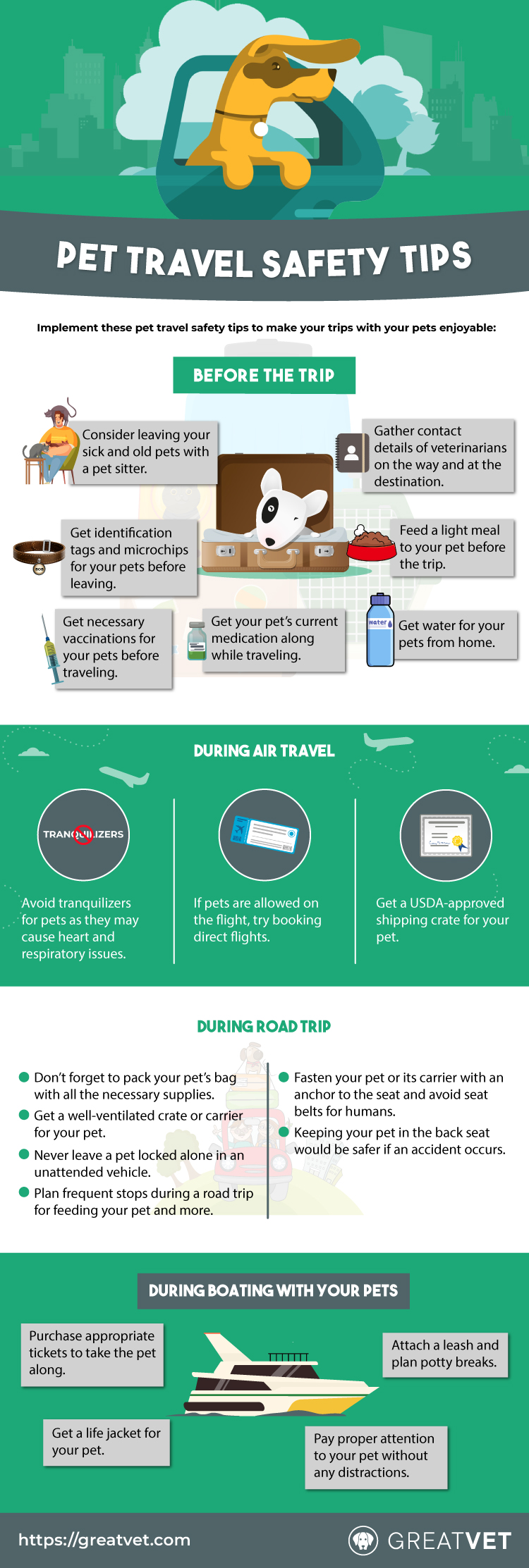Table of Contents
Some families find it impossible to consider going on vacation without bringing their pets. Many dogs like traveling, but if you aren’t ready, it might be unpleasant for both you and your dog. You can make your trip comfortable and safe for you and your dog by making advance preparations.
There are more pet-friendly travel alternatives available now than ever before, so pet owners may easily transport their animals by car, aircraft, or train with the proper planning. Consider what is safest and most comfortable for your pet while making travel selections. However, if you’ve made the decision that it’s better to travel with your pet, this is our advice for a worry-free journey –
Tips For Traveling With Pets On An Airplane
For animals with pushed-in faces, such as bulldogs, pugs, Boston terriers, and Himalayan and Persian cats, flying can be a little risky but not impossible or not doable. These brachycephalic animals are more susceptible to breathing problems and heat stroke, particularly in poorly ventilated or temperature-controlled environments, because of their shorter nasal passages and more constrained airways. So please consult a vet irrespective of your pet’s breed to know more and travel safe.
1. Health Certificate from Vets
Most airlines demand that your veterinarian produce a health certificate 7–10 days before your flight. Keep it with you at all times because this is a crucial document that could be examined at many checkpoints.
2. If feasible, choose the cabin above cargo.
Most airlines charge an extra cost to bring small dogs or cats into the cabin. Make reservations well in advance since there are restrictions on the number of animals that are allowed in the cabin.
3. Direct flight
Both you and your pet may experience stress while changing planes. If your pet needs to fly in the cargo hold, this is especially true. Choose aircraft that can handle temperature variations if you are carrying cargo and you will be traveling in the summer or the winter.
4. Your pet should get used to the crate/ carrier.
Give your pet a few weeks to become used to the travel crate. To make your pet more comfortable in a hard carrier, consider stuffing the bottom piece—with the top detached—with your pet’s bedding.
5. To your carrier, affix a travel label
Mistakes can occur. Give the airline a name, permanent address, contact information, ultimate destination, and a place where you or a contact person can be found as soon as the flight lands via the identifying label.
6. Prior to takeoff, avoid feeding.
Avoid giving your pet a meal two to four hours before a journey to avoid making them uncomfortable during the flight on a full stomach. The day before your departure, though, you should give your pet water and keep them hydrated.
We have gathered the most important information regarding safety tips for pet traveling. You may quaintly scroll through images to become familiar with the do’s and don’ts.

Tips For Traveling With Pets Via Road
It takes some planning to transport dogs in a car, especially on lengthy journeys. You can’t just go on vacation assuming you’ll be able to obtain whatever you need for your pet.
1. Don’t let dogs go free in/ out of the vehicle.
Pets not only have the potential to hurt themselves while going in and out of a vehicle, but they may also distract the driver and potentially function as a projectile in an accident, striking human occupants. Keep animals in crates or carriers that are fastened to the car with a seat belt or other secure hardware. It must be possible for your pet to stand up and turn around in the carrier or box.
2. In the rear seat, keep your pet
It is advisable to keep your pet in the backseat whether they are secured, in a carrier, or a cage since, like young children, they might be hurt by front-seat airbags.
3. Pets shouldn’t be allowed to peer out of windows.
Cats and dogs should remain in the vehicle. Pets exposed to harmful debris that might injure them and, in colder climes, air that could be driven into their lungs and cause disease. Additionally, never put a pet in the open pickup truck bed.
4. Prepare your rest stops in advance.
Plan rest stops in advance to give your pet a chance to stretch, go potty, and drink water. On lengthy drives, pets can easily become dehydrated, so pack a portable dish and make regular stops to give your pet water.
5. Provide identification for your pet
Never let your pet leave the car without a leash, collar, or ID tag. Before a trip, think about having your pet microchipped. In the event that they are misplaced, a quick scan will enable you to be recognized as their owner.
6. Never leave a pet in a vehicle alone.
Pets can suffer from major health risks from extreme cold or heat, such as hypothermia or heat stroke. When traveling, make sure your pet is always under supervision (even if that means taking turns with a friend or family member at a rest stop).
7. Keep feeding what they usually do
Pets’ GI discomfort might result from food changes. To prevent stomach distress, provide bottled water and your pet’s regular meals.
Pet Travel By Boat
Exclusively a few cruise lines allow pets, generally only on ocean trips, with the exception of service dogs. While some lines allow pets in individual cabins, the majority keep them in kennels. To learn about the regulations and ships that provide kennel facilities, get in touch with your cruise operator in advance. If you have to use the ship’s kennel, make sure it is weatherproof and keep an eye on your pet all the time.
General Safety Tips For Traveling With Pets
- Ensure that your pets have had all necessary vaccines, flea, tick, and heartworm treatments.
- In addition to collars and tags, microchips are a crucial tool for helping you find your dogs if they get lost while you’re out exploring. They can return to you with the aid of this little rice-grain-sized item.
- Fill their suitcases! Bring additional collars, leashes, toys, and bowls for water and food for your dogs.
- Don’t forget to bring water, snacks, and extra food. To avoid stomach issues because water quality differs from city to city, it is advised to bring bottled water or bottled tap water from home.
- Find a veterinarian who treats animals close to where you’re going. You’ll feel more at ease if you’re ready. You may find a qualified veterinarian close to your destination by using a variety of resources. (www.healthypet.com/accreditation/hospitalsearch.aspx)
- Bring identification, prescriptions, medical documents, and photographs of you and your dogs.
- In an emergency, first aid supplies are crucial.
- Keep in mind that animals don’t belong in hot cars! Heat stroke can be fatal and occurs quickly.
To Summarize
No matter how you travel, be careful to take care of your pet’s medical requirements. Make sure to include enough pet medicine for the whole trip, plus a little extra in case your plans change. Plan to pack a small, insulated travel cooler to keep the drugs cool if they need to be refrigerated.
Finally, do some research on the area. Locate local veterinary hospitals if possible.
Pet Travel Related FAQs
What is the safest way to travel with a pet?
If you’re going on a trip and want to bring your furry friend along with you, here are some tips on how to make sure that both of you have a great time!
- Make sure they get plenty of exercise before leaving.
- Pack all their favorite toys and treats in your bag.
- Bring along plenty of water for them
- Make sure they have all their shots up to date
What is the safest way to travel with dogs?
The safest way to travel with dogs are:
- Put your dog in a seatbelt.
- Put your windows up for a healthy puppy.
- Know your dog’s top speed.
How do you travel long distances with a dog?
- Avoid feeding the dog right before putting it into the car.
- Before forcing your pet to sit in the car, take him or her for a walk.
- Make your pet a bag for travel.
- To avoid hitting speed bumps, slow down when you are on the road.
- Despite the fact that your pet likes the window open, don’t let him/her hang out the window.
- Whenever you are going a long distance, stop for a half-hour break.
- When traveling with a small dog or a puppy, let the person sitting in the passenger seat take care of the animal.




